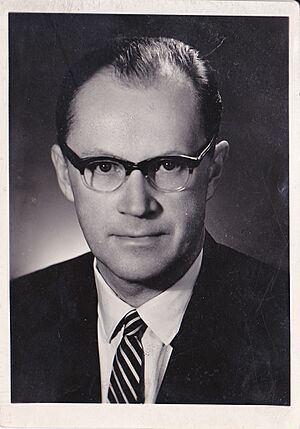Gunnar Kangro facts for kids
Gunnar Kangro (born November 21, 1913 – died December 25, 1975, Tartu) was an important Estonian mathematician. He mostly studied how to add up numbers in special ways, a field called summation theory. He taught many different math subjects at the University of Tartu, like mathematical analysis, functional analysis, and algebra. He also wrote several textbooks for university students.
Contents
About Gunnar Kangro
Gunnar Kangro was born in Tartu on November 21, 1913. He was the youngest of three children. His father was a construction engineer. After finishing Tartu Secondary Science School in 1931, Gunnar went to Tartu University. He studied mathematics there.
He graduated from the university in 1935. After serving in the Estonian Defence Forces, he became a junior assistant. This was at the Tallinn Technical Institute, which is now Tallinn University of Technology. In 1938, he earned his Master's degree from Tartu University. He then received a scholarship for his doctoral studies in 1940.
In July 1941, Kangro joined the military. He served until February 1942. Later, in 1943, he moved to Moscow University. There, he continued his research for his Doctor's degree.
Kangro came back to Estonia in the autumn of 1944. From November that year, he started teaching at Tartu University. He was the dean of the Faculty of Physics and Mathematics in 1947–48. He earned his Doctor's degree in July 1947. In 1951, he became a full professor. He led the Chair of Geometry from 1952 to 1959. From 1959 until his death in 1975, he was the head of the Chair of Mathematical Analysis.
His Math Discoveries
In his Doctor's thesis, Gunnar Kangro created a new way to understand how numbers come together. This helped him study problems with complex power series. He invented new ways to add up series that don't usually have a sum. He used these methods to find out more about power series. His work helped expand how certain math methods could be used.
In the 1950s, he worked with German mathematicians. They created a system for studying "summability factors." He combined ideas from modern functional analysis with older math methods. With his student Simson Baron, he began to describe these factors for double series.
Kangro also developed a theory about how fast numbers can be summed up. This theory used functional analysis. It helped him solve several problems in math. He not only created this new theory but also showed how it could be used. Sadly, his work was cut short when he passed away unexpectedly in 1975.
Teaching and Mentoring
After World War II, Gunnar Kangro greatly helped to update how mathematics was taught at Tartu State University. His courses on algebra and mathematical analysis showed the new ideas in math from the early 20th century. For example, he taught abstract algebra instead of just polynomials. He also based mathematical analysis on axiomatic methods and set theory. His course on functional analysis even started a new area of research in numerical methods in Tartu.
Kangro's biggest impact was helping to train a new generation of mathematicians. He guided 23 students who earned their Candidate's degrees in mathematics. Besides mathematical analysis, he also helped develop algebra, numerical methods, and geometry in Estonia. He was also key in changing how higher math education was organized at the University of Tartu in the 1960s. This was because more computer experts were needed.
Awards and Recognition
- 1961 member of Academy of Sciences of the Estonian SSR (now Estonian Academy of Sciences)
- 1965 Merited Scientist of the Estonian SSR
Books He Wrote
- 1948 Kõrgem algebra I, Teaduslik kirjastus, Tartu
- 1950 Kõrgem algebra II, Eesti Riiklik Kirjastus, Tallinn-Tartu
- 1962 Kõrgem algebra, Eesti Riiklik Kirjastus, Tallinn
- 1965 Matemaatiline analüüs I, Eesti Raamat, Tallinn
- 1968 Matemaatiline analüüs II, Valgus, Tallinn


